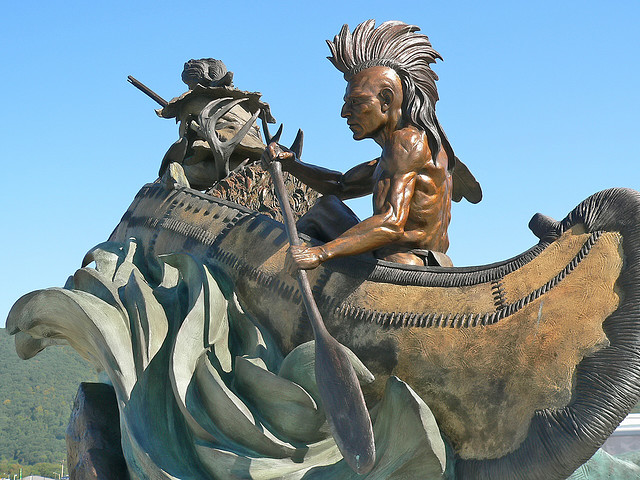Hunting for a sassy-looking sweatshirt, I stumbled across Cabela’s online frontier of testosterone. For those unfamiliar with the outfitter, the site doesn’t do justice to the consumer stadiums that CEO, Richard N. Cabela, has erected. However, it’s still a place where you can obtain all the necessary accoutrements for an Elk grinding session, or going ‘deep cover’ in the no-man’s land between Pittsburgh and Philadelphia.
Among their artifacts, I was pleasantly surprised to see Cabela’s paying tribute to, if not honorably sanctifying the legacy of my country’s original inhabitants via the sale of authentic Native American goods. Seeing as how this week is that special time of the year when Americans young and old come together in order to collectively indulge in enough food, mirth, and myth to sanitize the brutal genocide upon which America country was founded, I thought it would be nice to provide some shopping advice for this Friday’s consume-a-thon, and to pay tribute to the corporate tribe that has been gracious enough to supply the world with Eskimo Redneck Ice Chisels and 50 round rifle magazines. It’s my way of saying, “Thanks.”
Savvy consumers and sophisticated hunters will immediately take note there is not just one, but three different kinds of ‘Native’ knives available for purchase on the website. One could argue that the accompanying descriptions of the knives are painfully awkward given that the text functions as a shallow gesture to both Indian ‘authenticity’ as well as the mythos of the Frontier—the written equivalent of giving two radically different people the same “Wassup, bro” head nod with one movement—but then again the kind of person who would make such an argument likely hates America. Or at least the America that started when white people said it did. Anyhow, the first knife is called the Indian Dag (pictured above) and it features the intensely authentic “ornately beaded, fringed-cowhide scabbard.” (A scabbard is also known as a ‘sheath’ to pussies who don’t spend their free time hunting digital bears and perusing animal corpse dioramas.) The name of the item is perhaps a little misleading, because this ‘Indian’ knife was ostensibly used by “19th-century frontiersmen” who relied on them as a “last-ditch defense in dire situations.” (For example, when one is attacked by a band of bloodthirsty savages intent on scalping heads, raping women, and killing babies.) Like all Indian-ish artifacts, it was a “popular trading item.”
The second knife, the Beaver-Tail Dag (the hyphen is included free of charge), has a handle with “nature inspired lines” because everyone knows that Indians are, like, way into nature. While aesthetically speaking, Cabela’s seems to be making overtures to the kind of nature best enjoyed by Viking back-to-the-landers and other Norwegian metal aficionados for whom studded leather blades are the peanut butter to nature’s jelly, it’s more likely that I’m so out of touch with nature that I’m incapable of recognizing the inherent Indian-ness of this particular item. Fortunately, I live in a highly developed, civilized city where the local museums have long acted as noble stewards of indigenous clothing, tools, pottery, sacred objects, funerary possessions, as well as their bodies and body parts, so I can probably ask an expert for verification. Nevertheless, it’s a wonderful knife, and will likely stir ancient joy in those who cut or stab with it.
The third item is the Great Lakes Trade Knife, and it is accompanied by the longest and most historically illuminating description: “Traded to powerful Great Lakes tribes by the Hudson [should read Hudson’s] Bay Company in exchange for furs and trapping rights, this all-purpose knife style was common throughout westward expansion.” Cabela’s is correct about the expansion, but this is one of the rare situations where the Rhodes Scholars who write copy for the catalogue have their facts a bit wrong. While it is no doubt comforting for goateed, Under Armour-wearing, deer-killing white folks to imagine that the Hudson’s Bay Company gained legitimate access to both furs and trapping rights by trading simple objects within a Milton Freidman-style free market (in which aboriginal peoples could, of course, ensure fair value for their goods and services), the company was actually created through a royal charter under King Charles II in 1670 that granted full monopoly ‘trading’ rights over approximately 1.5 million square miles of land, or roughly 1/3 of what is now Canada.
Contrary to the logic of sane people, the British arbitrarily decided that this vast expanse of land was ‘theirs’, since the ancient law of man asserts the right for pigmentally-challenged people to claim anything and everything as their own private property, as long as they arrive at said destination by boat. (FACT: Even today, if a white guy can technically sail a boat right up to your house and dismount on your property, then it’s totally his for the taking.) Originally known as The Governor and Company of Adventurers of England trading into Hudson’s Bay (Brits are known for their subtle titles and economy of prose), The Hudson’s Bay Company functioned as a proxy government for the British throne, playing a critical role in seizing land, bullying natives, promoting moustaches, and advancing the economic, geographic, and genocidal imperatives of British colonialism. (For more info, see any Native history not written by white people, as well as the film, The Other Side of the Ledger: An Indian View of the Hudson’s Bay Company.) Today the company continues it’s storied legacy under the helm of Chairman/CEO, Richard Baker, a real estate investor, and one of the largest private owners of shopping centers in the United States.
But enough about the Hudson’s Bay Wool Blankets and Ethnic Cleansing Corporation. This post is about Cabela’s, the undisputed king of scent-controlled camo clothing, tomahawks, and head coverings suitable for ninjas, terrorists, beekeepers, conservative religious women, hillbillies, and residents of the planet Hoth. You might be saying to yourself: “Well, I do appreciate the tip on where to buy gear for my Spies Like Us re-enactment club, but did you really say tomahawks?!” Fuckin’ a’ right I did. Because in addition to Cabela’s Indian Print Muzzleloader Gun Case (pictured above), which uses “traditional horse blanket material” to create a distinct design that “hearkens back to another era,” the store also carries the newest, hottest, most bona fidest line of Native American Tomahawks.
These “authentic re-creations of Native American tools” are so real that you can almost imagine yourself imagining yourself as an actor whose is representing an image of the real thing! It’s pretty awesome. At first I was just attracted to the ‘beautiful craftsmanship and attention to detail” on these “great display pieces,” but I was lured in with the Tonto-esque Zen bombs dropped by Cabela’s ‘warrior’ staff of marketeers: “Native Americans of the 18th and 19th centuries were masters at living off the land. Nature supplied everything they needed to survive.” Whether seen as a tools, weapons, or tweapons gifted directly from the Great Spirit to the neoprene’d hands of man, there are three models from which consumers can choose, including the Stone Club (pictured above), which is the ideal choice for (a) those wishing to add masculine nuance to their existing ‘Indians-were-majestic-but-I’m-not-giving-back-this-mountain’ chalet decor, or perhaps (b) the smaller niche market shopper who simply wants to add Blunt Force Trauma to his or her resume. But what about the ever-crucial question of the item’s authenticity? In addition to repeating variations of the word ‘authentic’ in almost every sentence, the makers of the Native American Stone Club Tomahawk hammer the point home like a cinder block being dropped repetitively on the hood of an SUV: “This authentic, awe-inspiring re-creation centers around the 3″ x 4″ river rock bound solidly onto the leather-wrapped hardwood handle. It’s beautifully adorned with powerful symbols, including a medicine bundle, simulated eagle feathers for bravery, a fox bone for battlefield slyness and a tuft of pony hair. Includes a certificate of authenticity from its Navajo craftsman.”
Traditionalists will no doubt be in favor of the “no-frills representation” of the 19th weapon found in the Standard Tomahawk, but youthful lumberjacks and pot smokers will take pleasure in the item’s “formidable 4-inch blade on the front and pipe bowl on the back.” Unlike the kind of faux-tomahawks that circulate in American popular culture as part of the time-honored tradition of mocking, demeaning, and dehumanizing native peoples, this thing is the real deal. But “is it pressure-fitted to the crosshatched pipe/tomahawk shaft, just like the originals were nearly two centuries ago?” you might be asking yourself. Indeed. Indeed it is.
Cabela’s really saves the best for the last, though, with the “historically accurate masterpiece” known as the Navaho Tomahawk. Mixing the postmodern industrial economy of scale with the artisanal flair and attention to detail found in an Adderall addict’s sketchbook, this weapon/tool/tchotchke combines a “handmade 4-3/4″ steel head” with a “beautiful collection of powerful medicine, including beadwork, rabbit fur and feathers, accents the leather-wrapped handle.” This item is also “100% Navajo-crafted with a certificate of authenticity,” and this means that you’re actually getting a second guarantee for free, which is Cabela’s certificate of assurance that, if necessary, any critique of their gross commodification of Native history can be deflected with the proverbial Navaho human shield whose name appears on the certificate.
With your Indian knives in tote, your horse-blanket encased muzzleloader by your side, and your angry white fists clenched tightly around your 100% For Real tomahawks, you may need a few moments to wind down and relax. Once again, Cabela’s has you covered. From the vantage point of the new Lone Wolf Treestand that you’ve taken the liberty of bolting high on the living room wall above your Fallow Deer Faux Antler Cross (pictured above), you can stop looking furiously out the windows for savages and socialists and instead contemplate the “Indian Tribes” framed print designed by none other than Gary Crouch: Texas’s #1 cowboy hat-wearing resident expert on Indians, history, and Indian history.
In addition to the lovely tones, this artistic treasure offers a not-so-subtle reminder that the authority over Native identity is, quite logically, the same federal government which fought desperately to kill off the tribes it now ‘officially’ recognizes: “Artist, illustrator and designer Gary Crouch brings the history of the West to life in his stunning artwork. Crouch combines elements from paintings, photography and drawings in his creations, while also using a computer to blend handcrafted pieces from airbrush, oil and acrylic works. The result is something truly magnificent. “Indian Tribes” features a beautiful, unspoiled Western vista and lists the 150 tribes recognized by U.S. federal government. It also spotlights gemstone arrowheads and Native American dwellings in the border. Each is signed by the artist.”
If you aren’t yet convinced about how much Cabela’s loves, cherishes and respects the First Nations, it’s probably because you’re blind, queer, or haven’t yet seen the store’s stunning Kansas City shopping center tribute to the Osage tribe:
This is a little known fact, but the Osage are known equally for their bravery as they are for their love of jewelry. Zales, the jewelry store visible behind the bronzed warrior in the lead photograph, reportedly took its namesake from the Osage word, zalésË™h, meaning “shiny trinket.” Of course, I can’t be 100% sure that the story is true, but that kind of detail never seems to bother Americans on Thanksgiving.
****
Zack Furness encourages you to read the Native Appropriations blog and to check out the artwork and writing of Dylan Miner. He dedicates this piece to his childhood friend, Amy McCoy Sayers, who is now an Anishinaabe language teacher at the Ojibwe Charter School in Baawitigong (US/Canada trans-borderland.)
Lead photograph courtesy of mharrsch. Published under a Creative Commons license. Screenshots by the author.















Totally freaking brilliant. The only savvy response to cultural appropriation is mockery. If only it could overcome the profit motive . . .